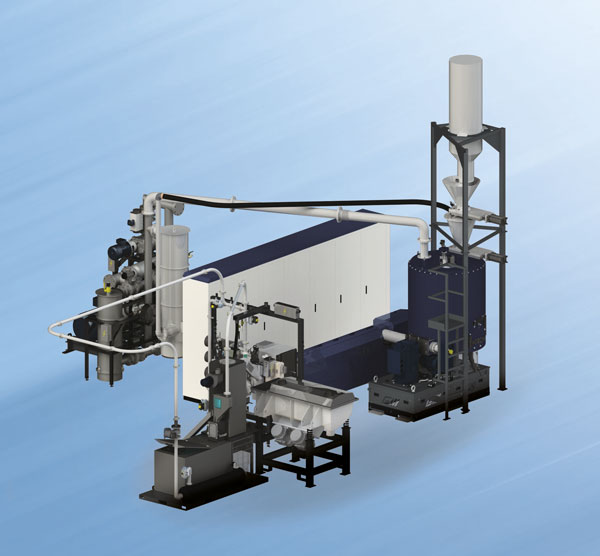 Gamma Meccanica applies its expertise and technology in the production of PET recycling plants
Gamma Meccanica applies its expertise and technology in the production of PET recycling plants
With 45 years of experience Gamma Meccanica S.p.A. today represents one of the main players on the international market in the construction of plants for the regeneration of plastics.
The regeneration of plastic materials is an essential element in the management of the life cycle of products and in respect for the environment. Being able to reduce the impact on the environment is one of the objectives of Gamma Meccanica and of many companies in the sector. The recycling of plastics brings significant benefits to the environment because it makes possible to create new high quality recycled plastic objects. This reduces the demand for raw materials, requires less energy during the productions process and reduces the amount of plastic going to landfill.
According to the report by Zero Waste Europe and by Eunomia Research & Consulting, PET is the most recycled plastic due to its multiple advantages over other types of plastic. It is a polymer widely used in the production of disposable packaging such as for beverage bottles and as a polyester fiber in textile manufacturing. It is also the most collected polymer – together with PP, Polypropylene, and PE, low- and high-density polyethylene (respectively LDPE and HDPE in acronym). It is ideal for food packaging as, being a very inert polymer, it has no interaction with what it comes into contact with.
As a result, the production chain that revolves around PET recycling is growing. The recycling to play its role in plastic waste management needs efficient processes in order to obtain high-quality end products that can compete with virgin materials.
Gathering a whole series of suggestions, information and requests from its customers, universities and partners, Gamma Meccanica offers a solution with excellent monetary value for the recovery of regrinds of PET-based products such as polyesters in general and polyamides. This technology is a modular solution that adapts to the different needs of PET recyclers.
 COMPAC DUV technology for the regeneration and crystallization of PET
COMPAC DUV technology for the regeneration and crystallization of PET
The COMPAC DUV technology proposed by Gamma Meccanica allows to carry out the first step of PET recycling, using vacuum and heat to obtain the least possible degradation of the material. Its main function is to prepare the material for immediate use after this first treatment or to prepare it for subsequent treatments.
Starting from bottle flakes treated by an effective sorting and washing plant, COMPAC DUV guarantees granules with an intrinsic viscosity equal to or greater than 0.7 dl/g. In this way the DUV prepares the material to be used for spinning, for planks production in food and non-food use, and for film.
If it is necessary to have IV values starting from 0.75dl/g up to 1.0 dl/g, it is foreseen the addition of the next step for the regradation which can be obtained with two other processes: LSP or SSP.
The main features of the COMPAC DUV compared to other solutions are a considerable saving in the cost of the system, the reduced size and significant energy savings.
Gamma Meccanica is also studying an LSP (liquid state polycondensation) plant to be combined with the DUV line, which would allow a rapid increase in the IV value to be mounted in line or alternatively a SSP (solid state polycondensation) plant to go so far as to produce IV that can replace the virgin material. The main purpose of the DUV are as follows:
1) Dry as much as possible the materials that undergo deterioration processes due to hydrolysis reactions during the subsequent extrusion phase.
2) Extract as much pollutants as possible from the material to be recycled in order to achieve ‘food approved’ grade.
The composition of the line
The Gamma Meccanica COMPAC DUV regeneration line consists of a vacuum reactor with Ecotronic technology to maintain temperature and reduce consumption, an extruder with a special screw profile, a screen changer with high filtration capacity, a melt pump, an underwater pelletizer TI and finally an in-line crystalliser.
The material is fed into the reactor through a double hopper feeding device equipped with special valves for vacuum sealing. From the first hopper, the material by gravity descends into the hopper below where a vacuum is created, and the material is ready to enter the reactor without altering its environmental characteristics.
In the reactor, the material is kept at a high temperature. In the case of PET this can be between 160°C and 190°C. In addition, a high vacuum level (up to 10 mbar) is maintained in the reactor. The vacuum serves to extract the moisture to a maximum of 50-100 ppm. With these residual moisture values, the drop in IV due to hydrolysis processes is practically zero.
A screen changer specifically for PET processing is connected to the extruder. Filtration has a great importance because it eliminates any impurities in the material and can be pushed as far as the elimination of particles as small as 30 microns. The filter can be a discontinuous or backflush type filter or a state-of-the-art continuous filter.
After filtration, the material enters the underwater pelletizer TI, which produces granules of the required size. If greater precision in the size of the final product is desired, a melt pump can be added.
Finally, there is an inline crystalliser. In this case, the residual heat in the granule is utilised to achieve energy-saving crystallisation.
The cooled granules (after crystallisation) enter a special centrifuge, and are stored in a silo, or loaded into big bags or other containers.
At the outlet we will then have PET granules that have undergone a minimum intrinsic viscosity drop (from 0 to a maximum of 3%), crystallised and if necessary suitable for use in contact with food.



